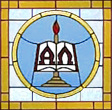 |

|
Digression 28: The CrucifixIt is widely believed in Christendom that Jesus Christ was killed on a cross. However, the Greek word 'stauros', which is normally translated 'cross' in English Bibles, really means a stake or pole. Indeed, the crucifix symbol probably has pagan origins. It is fitting that Christ died with hands and arms lifted up above his head, rather than spread out in a crucifix form, seeing that uplifted hands is a symbol of God's promises being confirmed (Eze. 20:5,6,15; 36:7; 47:14), as well as intense prayer (Lam. 2:19; 1 Tim. 2:8; 2 Chron. 6:12,13; Ps. 28:2), which Christ was engaged in on the cross (Heb. 5:7). He said that as the bronze serpent was lifted up on a pole when Israel were in the wilderness, so he would be publicly lifted up in his time of dying; thus he associated the 'cross' with the pole (John 3:14). The Roman Catholic Church has attached great mystical significance to the cross. This is completely without Biblical support; it has resulted in the crucifix becoming a talisman, a physical token that God is with us. People have come to feel that by wearing a crucifix or regularly making the sign of the cross, God will be with them. This is mere tokenism; the real power of the cross is through our association with Christ's death by belief and baptism, rather than recalling the physical form of the cross. It is easier, of course, to do the latter than the former. |